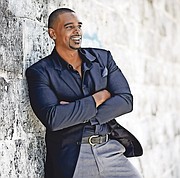Health coach Ethan Quant, of Elite Wellness Solutions, has succeeded in his weight loss journey and now wants to share his methods with the Bahamas in an effort to foster a culture of wellness and conquer the obesity epidemic.
We have all heard how important physical activity is for living a healthy and fit lifestyle. But what does that look like in the context of real life?
First, let’s define physical activity. The World Health Organisation (WHO) defines physical activity as “any bodily movement produced by skeletal muscles that requires energy expenditure.” Simply put, physical activity is any movement of the body.
My clients often come to me with some preconceived notions on physical activity which they equate to exercise. They say things such as, “I don’t like to exercise”, “I can’t exercise” or “I don’t have the time to exercise.” My job as their health coach is to help them to first appreciate the true definition of physical activity. Then I try to help them find something that they enjoy and can start to do right away, or at the very least, get them thinking about it. This depends on which stage of change they are at on their journey.
Getting more physically active doesn’t have to be looked upon as some insurmountable task. Rather, it can be approached in bite-sized chunks. It could mean taking the stairs, instead of the elevator at work. Parking a few spots further away from the door at the grocery store or doing some work outside in the garden are both ways for persons to become more physically active. If we simply take the time to look it’s easy to find small but effective ways to increase physical activity without major disruptions to our daily routines.
My outlook on nutrition is that there is a difference between eating healthy and eating for your goal. Similarly, the same approach can be taken to physical activity as these activities should match your goals.
It is incredibly important to understand which phase you are at and then find the appropriate physical activities to get you where you want to be. The best way to know this is to consult your health and lifestyle coach. However, here are the different phases of physical activity and a general idea of who would fall into these categories.
Phase 1: Function – Focuses on stability and mobility training (balance and movement)
• Obese and morbidly obese individuals
• People in rehab; working with a physiotherapist
Phase 2: Health – Focuses on movement training
This may be activities like going for walks, or getting used to walking up and down the stairs
Phase 3: Fitness - Focuses on load training
This is adding some sort of resistance training, which can be done by using weights, body weight or resistance bands.
Phase 4: Performance – Focuses on athletic performance
Training for a marathon or a boxing/MMA match.
The first thing to acknowledge when you are on the path to become more physically active is to know what your goals are. And yes, sometimes you have to break those goals down into smaller, more easily achievable ones based on your ability/capacity and move through the different phases.
Furthermore, you should be sure that the activities you choose are ones you enjoy doing. It is essential that you get the right trainer or join the right class that matches your needs based on the phase that you are at. That means you must always consult and work with your health coach to guide you and support you no matter where you are on your journey.
• Health coach Ethan Quant, of Elite Wellness Solutions, has succeeded in his weight loss journey and now wants to share his methods with the Bahamas in an effort to foster a culture of wellness and conquer the obesity epidemic.





Comments
Use the comment form below to begin a discussion about this content.
Sign in to comment
Or login with:
OpenID